Chrysalis
Introduction
A Chrysalis is the pupal stage of butterflies within the order Lepidoptera. The term is derived from the Greek word "chrysos," meaning "gold," referring to the metallic gold coloration found in some chrysalises. The chrysalis is a crucial phase in the butterfly's life cycle, characterized by intense physiological changes, including the development of wings and other adult structures. This process is known as metamorphosis.


Formation
The formation of a chrysalis begins when a caterpillar reaches the final stage of its larval life. It finds a suitable location, often the underside of a leaf or a tree branch, and spins a silk pad to which it attaches itself. The caterpillar then molts for the last time, shedding its skin to reveal the chrysalis beneath. This process is known as pupation.
Structure
The chrysalis is a hard, protective case that shields the developing butterfly from predators and environmental conditions. It is composed of a protein called chitin, which also forms the exoskeleton of insects and other arthropods. The chrysalis is generally oval in shape and can exhibit a variety of colors and patterns, often serving as camouflage.
Metamorphosis
Inside the chrysalis, the caterpillar undergoes a remarkable transformation. Its body breaks down into a soupy substance through a process known as histolysis. Simultaneously, new cells called imaginal discs begin to form the structures of the adult butterfly, a process known as histogenesis. These changes are regulated by hormones, including ecdysone and juvenile hormone.
Emergence
The emergence of the adult butterfly from the chrysalis is known as eclosion. The butterfly breaks the chrysalis open, often using a specialized structure on its head called the ocellus. After emerging, the butterfly must pump hemolymph into its wings to expand them and allow them to dry. It then takes its first flight.
Ecological Significance
Chrysalises play a crucial role in ecosystems. They serve as a food source for various predators, including birds, spiders, and wasps. They also contribute to nutrient cycling by breaking down plant material during the caterpillar stage and returning nutrients to the soil during the chrysalis stage.
